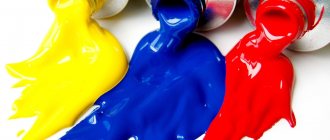Purple color: Unsplash Purple is a charismatic color. It is not surprising that Princess Diana, Queen Elizabeth and Duchess Kate Middleton loved him so much. How to skillfully introduce it into your wardrobe? Let's study all the nuances associated with the color purple and figure out how to wear it, using the example of the collections of Saint Laurent, Louis Vuitton and Gucci.
General value
Purple color is the result of mixing red and blue. This is the shortest wavelength radiation perceived by human vision.
The color scheme is called royal. In Byzantine times it was extremely difficult to obtain. For clarity: to prepare 30 g of paint, 250,000 mollusks with ink secretion were required. The dye was unusually durable and bright. But not everyone could use it, only rich and powerful people.
The situation changed only in the 19th century, when people learned to produce synthetic dyes. They cost much less. But purple still retained the name royal.
Purple is considered the most mystical color, which is why it is important in many religions. In Hinduism, the seventh chakra is colored in it, which is responsible for the connection of a believer with the cosmos. According to Feng Shui, color signifies spirituality and aristocracy. In Christianity it is sadness, affection, silence. In Islam it is a mirage, and in Buddhism it is a mentor, a spiritual father.
Interesting Facts
It is generally accepted that the violet spectrum belongs to cool shades. During the Middle Ages it was used for sewing mourning clothes. It was worn in the event of the death of the king or one of his family members.
Among the Incas, the color purple meant a person dominating a territory.
In Argentina, there lived a purple bear in a zoo. No, this is not a separate species. Originally he was white. But after taking medicine for dermatitis, the color changed. This is how the allergy manifested itself.
Medical Internet conferences
Khitrova M.A.
THE INFLUENCE OF COLOR ON HUMAN HEALTH AND PSYCHE
GBOU VPO Saratov State Medical University named after. IN AND. Razumovsky Ministry of Health of Russia
Department of Philosophy, Humanities and Psychology
Scientific supervisor – Ph.D. Chepelenko K.O.
“Color is a sensation that arises in the human brain as a reaction to light of a wave of a certain length that enters the retina of his eye” - G.E. Breslav is a Russian psychologist.
We know that a person sees thanks to the retina - the receptor apparatus of the eyes. It contains photoreceptor cells - rods and cones. The latter are responsible for color perception. There are three types of cones, each of which is focused only on a different color range: red, green or blue. Based on the degree of excitation of each type of receptor, the brain “judges” the intensity of the light flux in each color range and forms the sensation of a certain color.
In the early 30s of the 20th century, the therapeutic effect that colors have on the body was described by the Indian scientist D.G. Ghadiali. In his opinion, the organs and systems of the body are sensitive to certain colors, which influence their action. Knowing this, you can use different colors for medicinal purposes.
In the mid-50s, Swiss scientist Max Luscher developed a system that allowed any planar design to be encoded and represented in the form of Luscher colors and shapes. But his main creation is the method of color selections or the Luscher color test. It allows you to measure a person's psychophysiological state, activity, underlying personality problems and the causes of psychological stress, which can lead to the formation of physiological symptoms and disorders.
After many experiments, from 4500 tones and shades, colors were selected that most clearly influence human physiology and psychology. Research conducted by Luscher showed that color can change the functions of certain systems of the human body. For example, observing orange-red color increases heart rate, breathing, blood pressure, and has an stimulating effect. Dark blue color, on the contrary, brings calmness.
Nowadays, there are a number of artists whose paintings bring improvement to people’s health, for example, B. Talkambaeva, N. Roerich, D. Davitashvili. But there are paintings that have a negative impact on viewers: “The Scream” by E. Munch, “The Crying Boy” by D. Bragolin, “Water Lilies” by C. Monet and others.
Colors affect the soul; they can evoke feelings and thoughts that are soothing or exciting, sad or joyful. In the modern world, it is necessary to know and use the therapeutic effects of color on human health. Color is a broader and richer concept than light radiation. Color helps us understand the world around us, realize and remember events and phenomena, creating forms in the form of a limitation of space, surface and time.
Psychology of color: purple
In psychology, the color violet means duality, the struggle of opposites. This is because the red and blue that form it have different meanings. Red - life, emotionality, vigor. Blue - calm.
In psychology, the color purple is designed to hide, muffle feelings and raging passions. That is why women pay attention to it during pregnancy.
Shades of purple are also of particular importance:
- Dark purple with deep blue - sharpness, authority.
- With the addition of red - immaturity of feelings, capriciousness.
- Light colors - tenderness, romance, nobility.
What else does the color purple mean in human psychology?
- Borderline state. Often used during meditation, in various spiritual and magical practices.
- Knowledge. Encourages creativity, reflection, analysis, and intellectual development.
- Some peoples are in mourning.
- In dream interpretation, purple represents life changes.
- Wisdom. As stated above, this color is obtained by mixing the other two. This symbolizes harmony and balance of two energies.
In bioenergetics, plants that have a violet glow can cleanse a person’s aura.
Women in red are more seductive3
Naturally, if red lips attract men the most, then imagine how they will look after the one who is completely dressed in red. Scientists have proven that this color provokes thoughts in the minds that red is the color of a fatal, passionate and accessible woman. They also claim that women in red are warmer emotionally and are self-confident. Perhaps this is what makes them more accessible. This suggests the opposite conclusion: if you want to be left alone, then wear black clothes.
What does it mean
As is the case with other spectrums, violet affects men, women and children differently. What does the color purple mean in psychology?
For men
A man who likes purple shows himself to be a real tyrant at home and at work. He has a very complex character. You can soften it at least a little with praise, constant emphasizing dominance and superiority. Unquestioning obedience is also required here.
Another meaning of the color purple in male psychology is mental imbalance, hot temper, and incontinence.
For women
In the psychology of women, the color purple means:
- Unconscious desire for attention and recognition from others.
- Reluctance to build long-term relationships. Such representatives of the fair sex prefer to spend time alone, alone with their feelings, thoughts and desires. They like to immerse themselves in their inner world more than in another person.
- The woman is quite reserved. She does not like to be bright, to express her feelings and emotions.
- Activity and vigorous activity alternate with periods of apathy, melancholy and reluctance to do something.
Also in female psychology, the color purple means imbalance, unmotivated anger and aggression. If a woman’s favorite shade is the lilac shade of this spectrum, she can be considered a romantic nature who is constantly immersed in herself. If a lady likes purple, she is a fatal beauty who mercilessly breaks the hearts of her gentlemen.
For children
If your child always chooses purple, it’s worth considering. Sometimes this is a signal that he is depressed. There may also be problems finding a common language in a new team, for example, at school or kindergarten.
What else does the love of purple indicate in child psychology?
- A child is a dreamer and visionary. Often, fantasies help him cope with the rejection of the world around him and reality.
- Passion for something. This could be creativity, sports, reading books and much more.
- The child has an inferiority complex that developed due to flaws in appearance.
- There is a desire to withdraw into oneself, to isolate oneself from the outside world.
You can draw some conclusions after 5 years. Until this time, children use purple because of its brightness. And from the age of five, their temperament and character begin to manifest themselves, and their personality acquires special characteristics.
Gray (0)
Gray is neither color nor light nor dark. He is absolutely not annoying and has no mental tendencies. Gray color is the neutrality of both subject and object, both inside and outside, it is neither tense nor relaxed. Gray is not a territory that can be revived, but simply a border; the border as no-man's-land, the border as a contour, as a dividing line, as an abstract division to separate opposites from each other, "gray is only territory" as an abstraction.
The one who chooses the gray color, the border, in the first place, does not want to give himself away and wants to protect himself from all influences, so as not to get excited. In case of severe fatigue (as an expression of guarding) and in an exam situation, since they do not want to give themselves away, gray is often preferred to the others. The one who chooses the gray color in last place wants to attract everything within his borders, which may be perceived by others as interference. He considers gray a boring color and banishes its lifeless peace to the last place in the row. He prefers all other colors, full of affect, along with their contradictory tensions, because they express exciting experiences. One who rejects the color gray binds himself because of his own readiness for excitement and is afraid of being left out. He would like to exhaust all possibilities, striving to achieve the goal, and at the same time a state free from excitement. Anyone who puts gray in second place divides his world, on the one hand, into a zone that is compensatingly overvalued, which is represented by the color in first place, and on the other hand, into a zone represented by all the others that are next to gray, devalued or repressed colors, or, accordingly, life possibilities.
Even if gray is in third place, the discrepancy between the recognized colors up to borderline gray and subsequent colors is still so intense that first and second place should always be judged only as compensations. Colors that, during repeated test recordings, stand once before and once after gray, that is, they are either placed in front of the gray wall, then, in accordance with the instantaneous state of conflict, are hidden behind it again, such colors accompanying gray are charged with conflict, if only gray appears in the first half of the row.
According to statistics, gray color occupies, on average, sixth place. He can move up to fifth or seventh place without any doubt. In all other places he attracts attention. In case of fatigue and an examination situation, he moves to the front.
In clothes
Purple color attracts attention and emphasizes self-sufficiency. It is predominantly chosen by women. Their psychological portrait looks like this:
- They always behave strictly and reservedly. The exception is lovers of bright, flashy tones.
- They do not suffer from complexes. Sometimes they are even too self-confident.
- They always strive to stand out from others.
- They like to add mystery and mystery to their appearance. They often create a romantic image.
- They strive to show their status and well-being. As stated above, the color purple was used exclusively by wealthy people in the past. Now the situation has changed, but his perception remains the same.
Unlike black, purple does not slim and does not hide imperfections. Therefore, those who prefer it in clothing can be called brave people, independent of other people’s opinions.
Initially - white
What a blessing that we see the world in color! Without this, life would be boring and dull. However, a person does not immediately acquire color vision. The colored world opens up to the child in a certain sequence. First he perceives red, orange, yellow and green, and only then violet, blue and cyan. This may be because each color in the solar spectrum has a different wavelength.
White color occupies a special place. It is perceived as the color of absolute purity and, considered a symbol of something abstract, visually signifies emptiness. Please note: we perceive these black letters on a white background as an object in an impersonal, empty two-dimensional space. White color for artistic purposes can only be used when it is located between two aggressive tones or when it is used to decorate some surface that should attract attention (signs, warnings, advertising). White guide lines on a black or dark road background prevent traffic disruption, as they best attract the driver's attention. When you need to highlight the most important color, such as a fire-red fire sign, the optimal background for it is white.
In the interior
Shades of this spectrum are not often used in this area. All because he is considered aggressive, putting pressure on the psyche. But if you choose the colors correctly, the interior will look quite harmonious, because the color itself gives a feeling of warmth, coziness, and comfort.
How to decorate an apartment or house in purple colors? There are several examples:
- In the kitchen and dining room you don't have to limit your imagination. Even flashy tones are suitable here.
- In the bedroom it is better to choose softer shades, otherwise you will not be able to calm down and fall asleep. Pale purple with the addition of pink and lilac are suitable. Another option is to use purple to highlight one element.
- It is also better not to make the living room monochromatic. You can dilute the interior by adding milk or beige.
- Shades of the violet spectrum look good in children's rooms. For girls, designers recommend choosing purple or light lilac. For boys - plum combined with coffee or white.
It is also appropriate to use purple color when decorating a work office. It combines especially effectively with wooden furniture.
So that the widow's color does not become a bad sign at a wedding
If the newlyweds, despite signs and superstitions, still decide to have a purple wedding, they should take into account some recommendations.
Consider the fact that purple goes well with snow-white. You can use white as the basis for your outfit, and bright shades of purple can be used as additional decor. Even the most ardent guardians of beliefs, traditions and superstitions will not find fault with such a technique. The entire wedding reception can be decorated in white and purple colors.
As a purple accessory, the bride can have shoes, a bow-belt on her dress, or a bouquet of delicate orchids. The groom may be in a purple suit, but all these signs and beliefs do not apply to him. If desired, a man can wear a white suit, a purple bow tie or a shirt of this color.
Impact on mood and health
In most cases, the violet spectrum has a beneficial effect on humans. It calms, helps cope with tachycardia, evens out breathing, normalizes blood pressure, and eliminates panic attacks. There are other aspects:
- Opens up corners of memory hidden deep in the subconscious.
- Relaxes, relieves stress, promotes rapid sleep (in moderation).
- Helps get rid of anxiety, look at problems from the other side, and restore inner harmony.
- Accelerates the recovery of health after operations or serious injuries, including mental ones.
- With regular training, it improves vision.
- In mediation practices it is used to cleanse the mind of stereotypes and templates, and tunes in to sincere and selfless behavior.
- Activates creative thinking and encourages active activity.
Despite these benefits, sometimes a so-called color overdose occurs. In this case, a person faces a state of depression, emotional overstrain, and depression.
Caramel color adds romance4
People associate caramel with a carefree, joyful childhood. Thinking about caramel, a person becomes more cheerful and relaxed. A Travelodge study of 2,000 people found that people who had caramel-colored decor in their bedrooms had a more varied and fulfilling sex life. And although red tones encourage communication and passionate feelings, it is quite obvious that caramel color evokes the desire to have sex. It’s surprising, because most people associated sexual desire with sex.
Who likes the color purple?
Those who like the color purple have an unusual perception of reality. More often these are dreamers who prefer spiritual values to material ones. These can be creative people, for example, artists, musicians, writers.
Lovers of this color scheme have the following qualities:
- intuition;
- determination;
- empathy;
- vulnerability;
- independence.
These people are also distinguished by the desire to be different from everyone else. Sometimes it's extravagance.
Choosing the right shade
You can combine shades of snow-white and purple at a wedding, but you can do it a little differently. It is allowed to use lavender and lilac tones obtained from mixing white and purple. New shades carry a different symbolism; they are more related to dreamy, romantic, spiritual spheres. They are considered the flowers of poets and romantic lovers.
At a wedding, these delicate, light shades look quite natural. There can be a bunch of flowers in dark purple.
Other delicate shades at a wedding would include light sand, milky white, and soft pistachio.
Most often, signs concern young girls. If an older lady came to the ceremony in an eggplant outfit, skillfully trimmed in gold, silver, mint or light green, this would be quite appropriate.











